Episodes

Thursday Jun 04, 2015
Episode 133: Hemp Leaf Binding Tutorial
Thursday Jun 04, 2015
Thursday Jun 04, 2015
First, you’ll need some paper for the pages. The size is your choice but it should be thin. Hemp leaf binding ~ most Japanese bindings, in fact ~ favor thin pages and thin covers. Craft paper makes for a good cover as it is thick enough to be a cover yet thin enough to work properly. Then, get a scrap piece of paper the same height as your cover. On this scrap piece of paper we are going to mark the holes for stabbing.
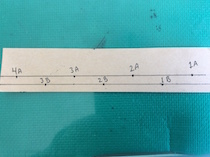
There will be seven holes. There will be two rows: one row will have four holes labelled 1A ~ 4A.; The other row will have three holes with clever names like 1B, 2B, and 3B. The row with four holes should be about 10 mm (a bit less than half an inch) from the edge. The row with three holes should be about 5 mm (half the distance from the edge to the row with four holes) from the edge. The distance between the holes should be the same.
Let's start at the very beginning, which I'm told is a very nice place to start. The beginning is the hard part.
Here’s the short version:
Start at 2A. Wrap the thread around the edge at 2AHere’s the slightly more intimate version:
Go to 2B, wrap the thread around the edge (wrap)
Go back to 2A. From 2A front, go to 3A.
From the back of 3A, go to 2B.
From 2B go to 3A again and wrap the thread around the edge.
Go to 3B and wrap the thread.
Go to 3A. From the back, go to 4A.
From 4A go to 3B.
From the back of 3B go to 4A and wrap the thread around both edges.
Go to 3A. From the back of 3A, go to 2A.
From 2A go to 1B and wrap it.
Go to 2A. From 2A go to 1A and wrap it around the edge.
Go to 1B, then back to 1A, wrap it around the other edge. Go to 2A.
Tie it off at 2A.
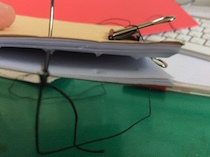
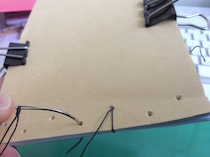
Go to 2B and wrap the thread around the edge, ending up at the back of 2B.
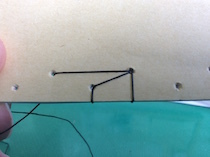
From the back of 2B, go to 2A. From the front of 2A, go to 3A. From the back of 3A, go to 2B.
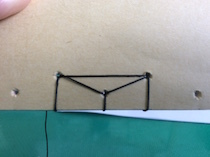
From 2B, go to 3A and wrap the thread around the edge.
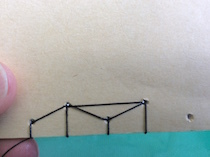
Go to 3B and wrap the thread around the edge.
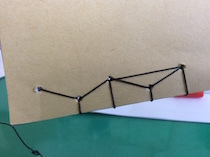
Go to 3A and from the back of 3A, go to 4A.
From 4A go to 3B. From the back of 3B, go to 4A
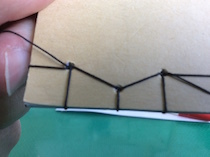
At 4A, wrap the thread around both edges.
From the front of 4A go to 3A.
From the back of 3A go to 2A.
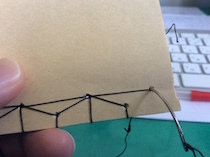
From the front of 2A go to 1B. Wrap the thread around the edge.
From the back of 1B go to 2A.
From the front of 2A go to 1A and wrap the thread around one edge.
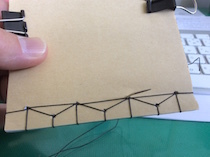
Go to 1B. From the front of 1B, go to 1A and wrap the thread round the other edge.
From 1A, go to 2A. Somehow find the end of the thread that’s in the middle and tie it off.
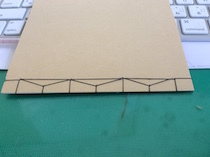
This should end up looking something like this. Hopefully, you'll be able to follow my instructions. If not, well, tell me about it.
But most of all, enjoy trying your hand at this binding, if you don't already know it.
Thanks for dropping by.

Thursday Apr 02, 2015
Episode 131: Schedules
Thursday Apr 02, 2015
Thursday Apr 02, 2015
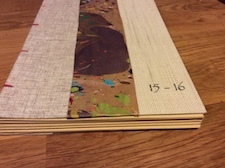 This is a 100-page A5 schedule book with pictures from the client to personalize it. The paper is 120 g/m2, which is, in my limited experience, too thick for this kind of book but the client liked it so all is well. A mistake (I thought I was buying regular paper) but it worked out. Fortunately.
This is a 100-page A5 schedule book with pictures from the client to personalize it. The paper is 120 g/m2, which is, in my limited experience, too thick for this kind of book but the client liked it so all is well. A mistake (I thought I was buying regular paper) but it worked out. Fortunately.The cover is made up of a variety of leftover pieces that I wanted to use before buying more. Since the client gave me carte blanche I gave it a shot. As you can see on the front, there are two different colored book cloths plus a bit of color in the
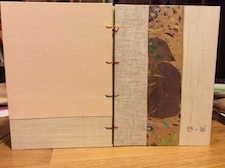 middle. The bit of color is actually an endpaper. Obviously it isn't big enough to use as an endpaper, so I used it to cover the seam between book cloths. The back was also comprised of leftover bits. It might look like two pieces but it is actually three; two just happen to be small pieces of the same design.
middle. The bit of color is actually an endpaper. Obviously it isn't big enough to use as an endpaper, so I used it to cover the seam between book cloths. The back was also comprised of leftover bits. It might look like two pieces but it is actually three; two just happen to be small pieces of the same design.Since the client wanted the book to open wide enough so they could use the entire page, I used coptic binding. This was good because Wednesday and Thursday are in the crease and are busy days. Lots of notes will be written in the margins of those two days. I also used multi-colored thread. The book is brown: the textblock, all the pieces on the cover. Even the endpaper I used on the front cover is brownish (with streaks of red and green). The colored thread gives it a little bit more personality.
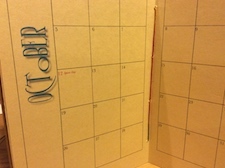 Speaking of endpapers, these, too, were leftover pieces: thicker Japanese paper (washi) cut to fit the covers.
Speaking of endpapers, these, too, were leftover pieces: thicker Japanese paper (washi) cut to fit the covers. The book itself has a yearly calendar for 2015 & 2016, a monthly calendar for April 2015 to March 2016 (the Japanese school year), and a weekly calendar. The monthly calendar is followed by the weekly calendar for that month. Just like the client designed it.
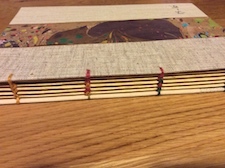
Next up? The 366-page schedule book.

Wednesday Feb 18, 2015
Episode 130: Jealousy and the San Francisco Center for the Book
Wednesday Feb 18, 2015
Wednesday Feb 18, 2015
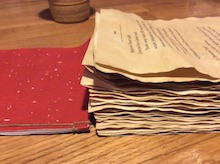 Regardless of my jealousy and frustration, I am making a book about soup. It is not merely a history of soup but includes characters such as Bishop Ussher, Hunt & Tony Sales (musical sons of Soupy), the last soups of famous people before they died (Julia Child had French onion), Duck Soup by the Marx Brothers, and soups in movies (Tom Jones comes to mind), and, of course, the Soup Nazi and his first appearance (Sleepless in Seattle.) It will be Japanese stab bound as is the red book in the photo at left.
Regardless of my jealousy and frustration, I am making a book about soup. It is not merely a history of soup but includes characters such as Bishop Ussher, Hunt & Tony Sales (musical sons of Soupy), the last soups of famous people before they died (Julia Child had French onion), Duck Soup by the Marx Brothers, and soups in movies (Tom Jones comes to mind), and, of course, the Soup Nazi and his first appearance (Sleepless in Seattle.) It will be Japanese stab bound as is the red book in the photo at left.The pages for the Soup book, titled: Soup: A Seasoned History, have been aged in tea & coffee and burnt around the edges. It is B6 in size and has 55 pages. Profusely illustrated, of course. I'm waiting to find a coffee bag to finish of the covers before I can sew it together. Maybe next year I can learn Japanese stab binding better at SFCB.

Wednesday Jan 14, 2015
Episode 129: Kikkado Notebook
Wednesday Jan 14, 2015
Wednesday Jan 14, 2015
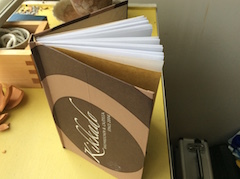 An A6 size notebook that fits nicely in one's pocket is pictured here. It was made of upcycled material. Specifically it was made from a box that a delicious New Year's Stollen came in. Unfortunately, I ate the cake so I can't send you any. The notebook is six signatures of four sheets resulting in about 84 pages. A handy size all around, I think.
An A6 size notebook that fits nicely in one's pocket is pictured here. It was made of upcycled material. Specifically it was made from a box that a delicious New Year's Stollen came in. Unfortunately, I ate the cake so I can't send you any. The notebook is six signatures of four sheets resulting in about 84 pages. A handy size all around, I think.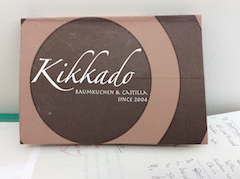 I sewed, glues, mulled, and put on those glue-on headbands much, much earlier last year and, when I saw the box the stollen came in I thought, wow, here's the cheap (i.e. free) book board I've been looking for. I spent a wonderful afternoon measuring, cutting, gluing, and finding endpapers.
I sewed, glues, mulled, and put on those glue-on headbands much, much earlier last year and, when I saw the box the stollen came in I thought, wow, here's the cheap (i.e. free) book board I've been looking for. I spent a wonderful afternoon measuring, cutting, gluing, and finding endpapers.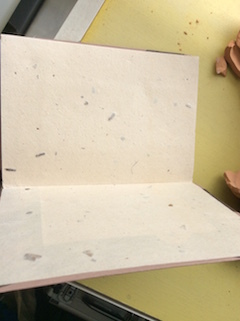 The endpapers are also upcycled.... I really don't like that word. It sounds too cutesy. The endpapers are also made from recycled material. I believe they are from a wrapping that another purchase was wrapped up in.
The endpapers are also upcycled.... I really don't like that word. It sounds too cutesy. The endpapers are also made from recycled material. I believe they are from a wrapping that another purchase was wrapped up in.
Sunday Jan 04, 2015
Episode 128: Planning! Or Failing to do so...
Sunday Jan 04, 2015
Sunday Jan 04, 2015
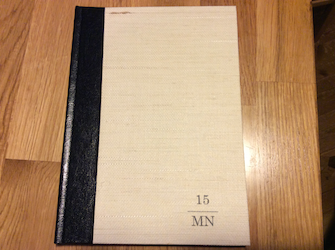 This is a planner that was supposed to be presented as a Saturnalia present back on December 25th but I got a bit backed up. Well, with running around shopping at least.
This is a planner that was supposed to be presented as a Saturnalia present back on December 25th but I got a bit backed up. Well, with running around shopping at least.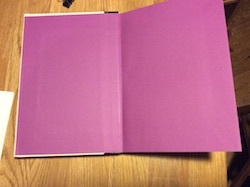 As you can see, it has purple endpapers that are intended to match a pair of chairs that will be delivered at the end of January, another Saturnalia present arriving fashionably late.
As you can see, it has purple endpapers that are intended to match a pair of chairs that will be delivered at the end of January, another Saturnalia present arriving fashionably late.It comes with a weekly calendar, a monthly calendar, and two yearly calendars. It also has lots of space for note-taking; for example, the weekly calendar is on the left side while the right side is blank. A request from the recipient.
This is the fourth book I've made so far this year and it's only the fifth of January. I will definitely not say I will be making a book-a-day for 2015 but I'm off to a good start. The other three books were kind of a fluky thing.
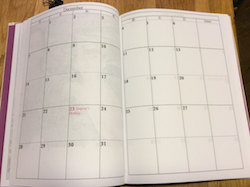 I had this badly printed novel on my desk for a while (like a year or more ~ the novel is Tristram's Printer). It was printed on only one side of the paper and I contemplated occasionally, what to do with it. One option, which came up frequently, was to trash it. Another was to Perfect bind it. The last option was to use a Japanese stab binding which is the one I went with. However, a 200 page novel is hard to stab. So I divided it up into five mini-novels which are pretty much divided along chapter lines. On the second day of the first month of the year, I stabbed section one.
I had this badly printed novel on my desk for a while (like a year or more ~ the novel is Tristram's Printer). It was printed on only one side of the paper and I contemplated occasionally, what to do with it. One option, which came up frequently, was to trash it. Another was to Perfect bind it. The last option was to use a Japanese stab binding which is the one I went with. However, a 200 page novel is hard to stab. So I divided it up into five mini-novels which are pretty much divided along chapter lines. On the second day of the first month of the year, I stabbed section one.This stabbing was followed on the third and fourth. When I finish all five sections I hope to make a small clamshell box for them and title it Tristram's Printer's Skeleton as the pages have been edited in red and black pen. Lots of corrections.
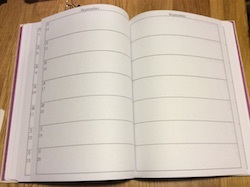 On the last two pictures you can see a monthly calendar followed by a weekly calendar. On the weekly calendar you can also see how much space is available for writing: the entire right-hand page. The previous planner had a weekly calendar on both pages but the recipient requested more writing acreage which I happily provided.
On the last two pictures you can see a monthly calendar followed by a weekly calendar. On the weekly calendar you can also see how much space is available for writing: the entire right-hand page. The previous planner had a weekly calendar on both pages but the recipient requested more writing acreage which I happily provided. Speaking of casing in books, I believe I have about 14 uncased books lining my desk. Does that mean I will case in 14 books in the next two weeks? One can only hope. Especially considering that two of them were intended as year-end presents.

Thursday Oct 02, 2014
Episode 127: Cigarette Machines
Thursday Oct 02, 2014
Thursday Oct 02, 2014
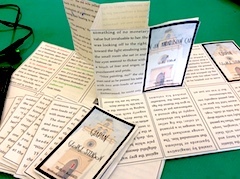 Art-o-Mat sells art through used cigarette machines. Artists may submit their work to Art-o-Mat but it must meet certain requirements, like size. This is a great idea for not only recycling used cigarette machines but for also distributing art to people walking down the street. Go to: Art-O-Mat.
Art-o-Mat sells art through used cigarette machines. Artists may submit their work to Art-o-Mat but it must meet certain requirements, like size. This is a great idea for not only recycling used cigarette machines but for also distributing art to people walking down the street. Go to: Art-O-Mat.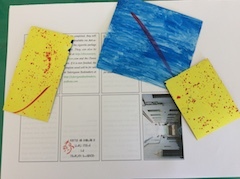 The book is called Giapan: A Quixotic Love Story. It is about a gypsy nun (La Gitana) and a wanderer (Giapan) who find themselves working for King Phillip of Spain shortly before the Spanish Armada sets out on its fateful voyage. The nun and the wanderer cross paths with a famous Spanish novelist who works briefly as a tax collector for King Phillip; until he is arrested for embezzlement.
The book is called Giapan: A Quixotic Love Story. It is about a gypsy nun (La Gitana) and a wanderer (Giapan) who find themselves working for King Phillip of Spain shortly before the Spanish Armada sets out on its fateful voyage. The nun and the wanderer cross paths with a famous Spanish novelist who works briefly as a tax collector for King Phillip; until he is arrested for embezzlement. 
Thursday Sep 11, 2014
Episode 126: More Japanese Binding
Thursday Sep 11, 2014
Thursday Sep 11, 2014
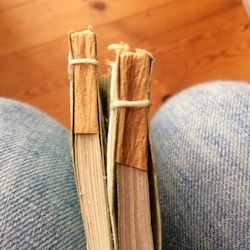 The first picture is a picture of my be-jeaned knees. Pretty, no? Between the knees you can see the kado-kami (edge papers) that support the text block and go under the cover and around the corners at the head and foot of the book. You can also see the thread wrapping around the edges.
The first picture is a picture of my be-jeaned knees. Pretty, no? Between the knees you can see the kado-kami (edge papers) that support the text block and go under the cover and around the corners at the head and foot of the book. You can also see the thread wrapping around the edges.This second picture is of the covers of the two recycled volumes of The Priests of Hiroshima: An Historical Love Story. What is the story about? A medical student and a Japanese student discover an antique bookstore in Istanbul with a talking cat that has perfected time travel. They go back to Mainz,
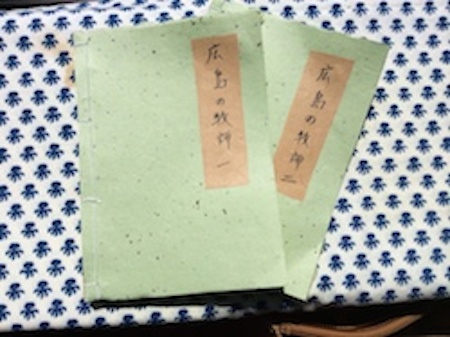 Germany to watch Gutenberg build his printing press, avoid arrest, watch a nun and priest fall in love, and discover their joy of life. Nothing whatsoever to do with Hiroshima or those semi-famous priests.
Germany to watch Gutenberg build his printing press, avoid arrest, watch a nun and priest fall in love, and discover their joy of life. Nothing whatsoever to do with Hiroshima or those semi-famous priests.One of the better things about the Japanese binding? It can be done fairly quickly with no waiting around for glue to dry. (Except for the kado-kami.)

Tuesday Sep 02, 2014
Episode 125: Ear Cleaning Japanese Binding
Tuesday Sep 02, 2014
Tuesday Sep 02, 2014
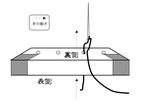

The shaded areas in the picture on the left are the Kado Kami (角紙) that supports the corners of the spine. On the right are the Koyori Kami (コヨリ紙) that supports the text block itself. In this picture the twisted paper is put through two holes; some instructions are for only one hole.
Plus, an easy to watch speed version of sewing six signatures of a blank notebook: Binding Six Signatures.

Tuesday Aug 19, 2014
Episode 124: Barber of Whitman
Tuesday Aug 19, 2014
Tuesday Aug 19, 2014
Serendipity brought me around a bit into American culture. First I listened to an interview with the soprano Renee Fleming who talked about Samuel Barber (Of course, she said) so I had to look him up on YouTube. Below one Barber video was another about Walt Whitman and Leaves of Grass, so I listened to and read about Uncle Walt and his poetry. This inspired me to print out my incomplete novel: Caraculiambro.
Definitely think I'm over a certain funk about bookbinding which is a good thing because I have a lot of naked books that need covers and ideas for more books. Plus writing a couple.

Wednesday Aug 06, 2014
Episode 123: Cheap & Cheep & Over the Funk
Wednesday Aug 06, 2014
Wednesday Aug 06, 2014
I see great book covers by people like Susan Mills or Hedi Kyle or Don Etherington and I think to myself, how can I accomplish that? And I get into an artistic funk depression and am consumed by what's the use? That is another word for being too lazy to work through problems but it is still a real problem. It takes time to pull yourself out.
The end result, of course, is I haven't bound a book recently and have about eleven waiting for covers. I have, however, managed to conquer the funk and am starting afresh with a positive attitude. This positive attitude can be seen in the fact that I made my first podcast in two months.

